INTRODUCTION
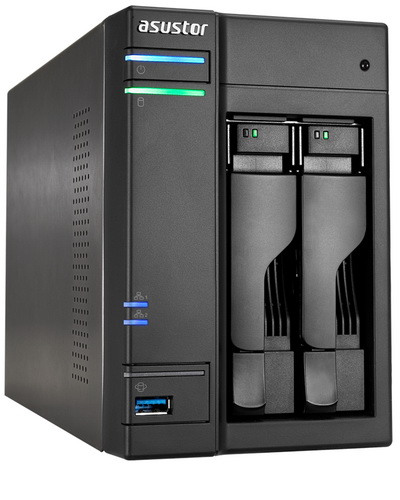
We may have pointed it out quite a few times in the past but NAS servers have made their way into thousands of homes all over the world. Now as some of you are aware many years ago NAS servers were used just as centralized network storage in small and large businesses but as technology advanced so did NAS servers allowing them to take on many new roles. So leaving out the centralized storage use (which still applies) currently NAS servers can also be used as web servers (for website hosting), email servers (which not only send and receive but also filter and even check incoming messages for viruses), download servers (used to download data both directly via HTTP/FTP and/or via torrent), cloud storage servers, media servers (can share/seed media wired and wirelessly to computers and smartphones), network video recorders (IP camera compatibility grows longer each day), virtualization stations (allows the NAS to be used with different operating systems) and even as media players. The AS6302T All-In-One NAS is the latest model by ASUSTOR in their Home to Power User line and since it comes packed with a good number of features we asked if we could check it out and we did.
Founded in 2011, ASUSTOR Inc. was established via direct investment from ASUSTeK Computer Inc. The ASUSTOR brand name was created as a portmanteau of “ASUS” and “Storage”. ASUSTOR is a leading innovator and provider of private cloud storage (network attached storage) and video surveillance (network video recorder) solutions, also specializing in the development and integration of related firmware, hardware and applications. We are devoted to providing the world with unparalleled user experiences and the most complete set of network storage solutions possible.
Under the hood of the brand new 6302T dual-bay NAS ASUSTOR has paired the brand new Intel Celeron J3355 dual-core CPU clocked at 2GHz (64-Bit model with 2MB of L2 cache, 10W TDP and a burst speed of up to 2.5GHz - includes Intel HD Graphics 500 with a base frequency of 250MHz and 700MHz burst) with a total of 2GB SO-DIM DDR3L RAM running at 1866MHz (dual channel - expandable to 8GB). In terms of available connectors the AS6302T features four USB 3.0 ports (including one Type-C port), HDMI v2.0 port (4k playback supported), S/PDIF digital audio output and two RJ-45 Gigabit Ethernet ports (support link aggregation) while the two 3.5/2.5" drive bays can be configured in single, JBOD, RAID 0 and RAID 1 modes. We do have concerns about the 2GB of SO-DIMM DDR3 RAM ASUSTOR decided to use (we recommend 4GB especially when 4k playback is a strong selling point) so since the only way of really finding out is moving forward with our review let’s do exactly that.
SPECIFICATIONS AND FEATURES

PACKAGING AND CONTENTS
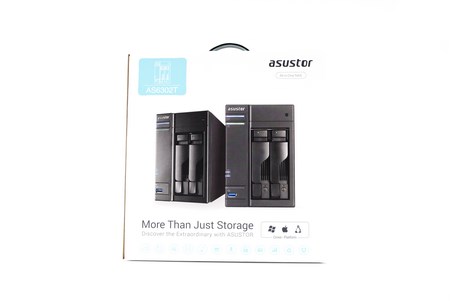 Just like with most NAS by ASUSTOR the front of the box has two product pictures, sticker of the product name and a cross-platform (OS compatibility) logo at the bottom.
Just like with most NAS by ASUSTOR the front of the box has two product pictures, sticker of the product name and a cross-platform (OS compatibility) logo at the bottom.

 The majority of available uses are showcased on the left side of the box while on the right we see the product specifications and available mobile apps.
The majority of available uses are showcased on the left side of the box while on the right we see the product specifications and available mobile apps.
 Moving at the rear we also find a short list of available usages printed in 19 languages.
Moving at the rear we also find a short list of available usages printed in 19 languages.
A thank you message from ASUSTOR and 5 2D barcodes are the first things you will see once you open the box.
As always the NAS is wrapped inside a plastic bag and placed between two thick foam spacers (the rest of the bundle is placed inside another cardboard box).
 Contained inside the box along with the AS6302T NAS and its power adapter and cord are two RJ-45 Ethernet cables, two small bags with HDD mounting screws, software/documentation CD, user manual and what seems to be a cable holder.
Contained inside the box along with the AS6302T NAS and its power adapter and cord are two RJ-45 Ethernet cables, two small bags with HDD mounting screws, software/documentation CD, user manual and what seems to be a cable holder.
THE AS6302T
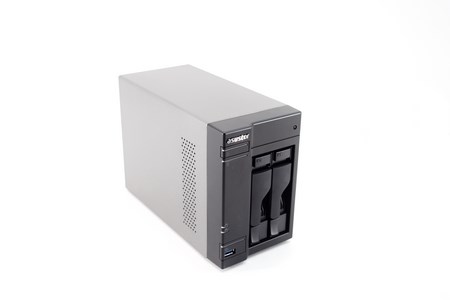 Measuring 230mm in depth, 108mm in width and 163.5mm in height the 2Kg heavy AS6302T looks a lot like its predecessors.
Measuring 230mm in depth, 108mm in width and 163.5mm in height the 2Kg heavy AS6302T looks a lot like its predecessors.
 As usual the top removable cover is made out of aluminum and is partially perforated on the right side.
As usual the top removable cover is made out of aluminum and is partially perforated on the right side.





The fascia is as expected made out of plastic and aside the two removable drive trays it also has the company logo, activity LEDs (power, HDD, network and USB), USB 3.0 port and an IR receiver.
 Both drive trays are made out of aluminum and plastic and can accommodate both 2.5" and 3.5" drives.
Both drive trays are made out of aluminum and plastic and can accommodate both 2.5" and 3.5" drives.
 At the rear of the NAS we find the USB 3.0 Type-C port, HDMI v2.0 port, two USB 3.0 ports, two Ethernet ports, S/PDIF digital audio output, reset button, Kensington lock and the DC in.
At the rear of the NAS we find the USB 3.0 Type-C port, HDMI v2.0 port, two USB 3.0 ports, two Ethernet ports, S/PDIF digital audio output, reset button, Kensington lock and the DC in.
 You can access the interior of the unit by removing the three screws found at the rear.
You can access the interior of the unit by removing the three screws found at the rear.
Accessing most of its modules is not easy (thus we didn't take pictures of them) but you can still replace the two stock SO-DIMMs.
 Using dual-channel with the AS6302T was a good move but restricting consumer choice to just a 2x1GB model is not how we'd do it.
Using dual-channel with the AS6302T was a good move but restricting consumer choice to just a 2x1GB model is not how we'd do it.
 With two Enterprise NAS 6TB drives mounted on its trays our tests can now be under way.
With two Enterprise NAS 6TB drives mounted on its trays our tests can now be under way.
SETUP
The easiest and fastest way to setup any ASUSTOR NAS to launch their very own control center software, wait until it locates the unit in your local network and then start the setup procedure.


The installation wizard will ask you to place a drive in the unit and even to to update the firmware which you can do either directly from the ASUSTOR server or from a firmware file (if you have it from the official ASUSTOR page).
After that you can choose between the fast 1-click setup and the custom setup (typically we followed the custom route).




Via the custom route you will need to set the server name (if you don't like the default one), server password, time zone, network options and configure the drives (single/RAID/JBOD) in order to proceed.
ASUSTOR has inserted a new page in the setup procedure from where you can choose to automatically install apps based on the type of usage you plan for the NAS (Home/Personal or Business).


Of course you have the ability to check which these apps are and choose to install them (or not).
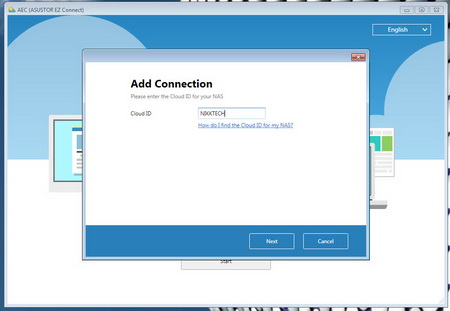



ASUSTOR has also introduced the EZ Connect app (Cloud access) which allows you to access the NAS from anywhere in the world and as you can see setting it up is extremely easy.
ADM 3.0.3.RAI4 PART 1

For this test we used the latest 3.0.3.RAI4 version of ADM to test the AS1004T and just like previous versions the main screen includes all the applications installed by default (you can access the layout settings menu and logout, restart or shutdown the NAS from the admin selection on the far right of the top bar).
As with all ADM versions to date from the Access tab you can add/remove user accounts, groups, domain users, domain groups and you can also create shared folders and set application privileges.
The Activity Monitor allows the end user to monitor the NAS so from here you can check the available space on the installed drive(s), check the CPU/Memory/Network utilizations and see what processes are currently running.

From the App Central you can see which applications are currently installed and add more.
ASUSTOR has started to compete with QNAP since aside their "official" ones their App Central has a current total of 278 available applications.
You can access information regarding all aspects of the ADM OS from within the Online Help tab.
The Backup & Restore tab allows you to remote sync options, setup FTP/Internal/External backup jobs, configure the one touch backup (front USB port), use the cloud backup feature (via Amazon S3) and also adjust the system settings.
From the External Devices tab you can check the state of attached drives, format them, prepare them for ejection and you can also check the state/adjust the settings for attached printers, Wi-Fi adapters and UPS devices.
The File Explorer page allows you to upload and download files from and onto the NAS without much effort (although i do recommend mapping a drive letter from your network options in Windows since it simplifies things quite a bit).


Under the Services tab the end user can find several server options for Windows/Mac OSX/NFS/FTP Server/WebDAV/Web Server/MySQL Server/Terminal/ MariaDB (MYSQL compatible) and SNMP use (PHP cashing is supported).
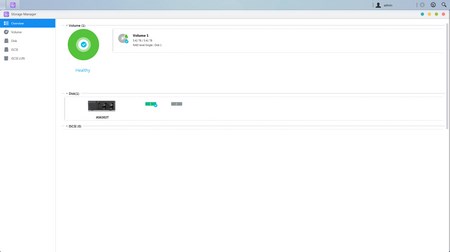

Everything related to the installed drives is placed inside the Storage Manager tab so here you can create and manage volumes (JBOD/RAID), check the state of the drives via SMART and use the iSCSI feature.
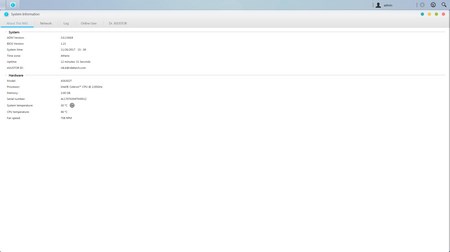

The system information tab does exactly as it says so from here you can check the model name and device status, check logs and even use the Dr. ASUSTOR feature (diagnostics).
ADM 3.0.3.RAI4 PART 2
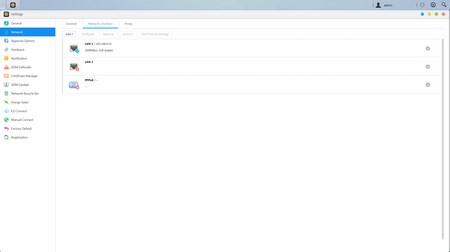






Pretty much everything else is placed inside the settings tab so from here you can adjust including the network settings, regional options, hardware options (LEDs/Buzzer/Fan control/Power settings/LCD text), various notification options, ADM defender (firewall), ADM update (manual or automatic), network recycle bin, energy saver (drive standby mode/fan control/wake on LAN), ease of access (EZ Cloud Connect/EZ Router/DDNS), factory default settings and product registration.
Via the photo gallery application you can view and share pictures stored in the NAS.
The SoundsGood application allows streaming of music onto mobile devices and once again it looks a lot better compared to its predecessor.
From the Download Server tab not only can you download files using the BitTorrent Client but you can also use it to download files directly from HTTP/FTP.
Linux Center allows you to install and use the Debian 8 OS onto the NAS.
ASUSTOR has launched a VPN server software which allows you to setup your very own secure virtual private network.


ASUSTOR may have added more camera models in their Surveillance Center but it still needs work since this time over it failed to detect automatically any of our 4 installed IP cameras (2xLinksys, 2xTRENDnet).


We were of course able to setup all of them thanks to the ONVIF compatibility mode and some extra tweaking but most consumers will not call that easy.
ADM PORTAL
Many people connect their NAS directly onto their TV sets so manufacturers have improved that area quite a bit. So as you can all see ASUSTOR has made it possible to access the surveillance app, ADM OS, Chrome, Chromium, Netflix, YouTube, KODI, Surveillance Center and many more (if you choose to install them) from the HDMI output.
The ADM portal has several settings which can be configured some of which are seen above.
KODI is the choice of most people for video playback (especially 4k) and the latest available version (v17.3 here) looks a lot different than previous ones.












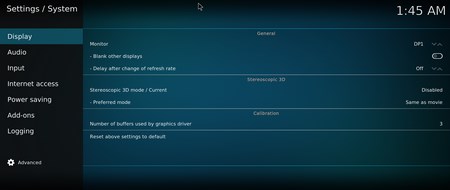


You can personalize the KODI application quite a bit (for example change the skin of the menus and set the region/language/audio language options).



You can also check the various hardware/software information screens and of course adjust video and audio settings (with 66% of the units total memory taken just by running ADM and KODI you can see why we were quite concerned about the amount of RAM - not to mention the up to 80% load on the CPU / possible KODI bug?).
Netflix may come in handy for some people but since we don't have a subscription we couldn't check it out.
Accessing the ADM OS via HDMI may not be as smooth as when you do from your computer but still it can come very handy.




Although the AS6302T can indeed reproduce "light" 4k material (samples) it was unable to do so with our full Blu-Ray rips (frame by frame playback - we use the same for media player testing). Naturally it was also capable of reproducing full Blu-Ray rips of Full HD movies (including our Avatar RIP) but when a manufacturer promotes 4k media playback that's only natural.
ANDROID/IOS APPS
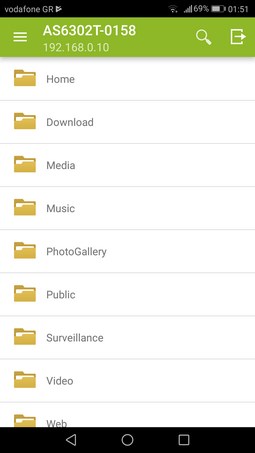










Just like in the past ASUSTOR still has several applications available for Android and iOS compatible devices including the AiData which allows the user to access files stored in the NAS, AiMaster which you can use to monitor and access most unit functions and details, AiFoto for picture sharing (you can also create online albums and instantly backup taken pictures from your mobile device to the NAS), AiVideo which allows playback of media stored in the NAS and online/offline transcoding, AiMusic for audio streaming, AiRemote which basically turns your smartphone or tablet to a mouse which you can use to navigate HDMI applications, AiDownload for HTTP and BitTorrent downloads and the AiSecure app which grants you access to your IP camera feed (we recommend using the auto IP/NAS discovery with each app).
TESTING METHODOLOGY – PERFORMANCE RESULTS
Originally we had decided that since some of the NAS servers/devices we've tested in the past are no longer in our possession (naturally) we would keep performing the exact same testing methodology we did in the past for as long as possible in order to provide accurate comparison results. However since our real-life tests are not enough for some people we also decided to throw in ATTO and Crystal Disk Mark to cover the more demanding users. However as always we will be using a single Seagate Constellation ES.3 4TB SATA III and up to 10 Seagate Enterprise NAS 6TB SATA III hard disk drives with 3.5” compatible units (we switched to 6TB models for RAID tests since May 2017) and up to two (for now) Enterprise Capacity 2.5 HDD V3 2TB SATA III HDDs with 2.5” compatible units to perform several upload/download tests with 10.9GB (Single) and 40,8GB (RAID) files. Tests are repeated a total of 4 times after which we record the average numbers (from the 4 peak ones) into our charts. The network device used for 1GbE tests is the same Netgear D7800 Gigabit VDSL Modem/Router we’ve been using lately when performing tests on NAS servers. Since the 25th of June 2015 for 10GbE tests we’ll be using a Netgear ProSafe XS712T 10G Smart Switch and an Intel XT540-AT2 10GbE PCIe card (10GbE compatible NAS cards will be provided from each company and stated in each review).
SINGLE DISK TESTS
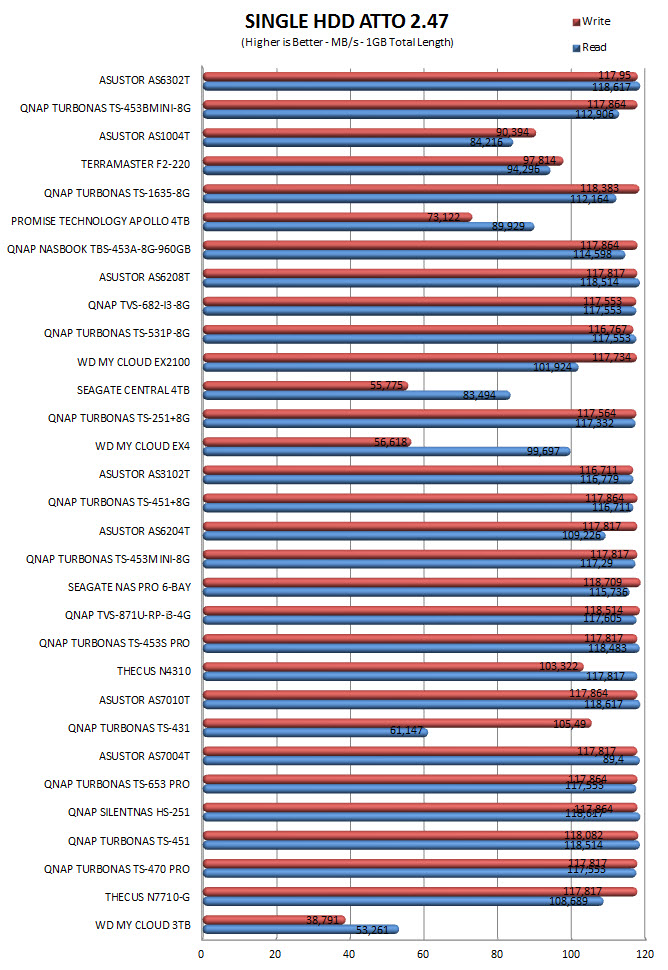


RAID TESTS



TEST RESULTS – TEMPERATURES / CONSUMPTION / NOISE
HDD TEMPERATURES

POWER CONSUMPTION

NOISE LEVELS

CONCLUSION
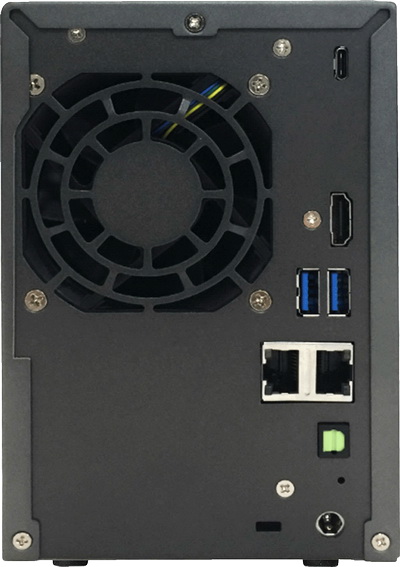
After wrapping up all our tests the AS6302T leaves us with mixed feelings. For starters as you can all see performance in our data transfer tests although certainly not stellar is very good and so the AS6302T should cover even the most demanding consumers in that area. The ADM has also grown to be one of the best OS for NAS in the market today (for us it’s only second to QNAP’s QTS) so no problems there either. Power consumption and noise levels are also quite low so again nothing wrong with the AS6302T here either. Also using an HDMI v2.0 video output and an S/PDIF digital audio output are two things we don’t see very often (especially with mid-end NAS models) so kudos to ASUSTOR for that too. However the AS6302T has a serious drawback and that’s its really bad 4k playback. Now there’s always a chance this is a OS or KODI bug which may get fixed really soon and you can always try adding more RAM to see if this improves things. Still as things stand if you’re interested in a NAS which can also playback heavy-bitrate 4k material the AS6302T is clearly not it.
Since the AS6302T is a home oriented model it’s quite affordable so currently it’s available for USD345.81 inside the USA (Amazon.com) and for 385Euros inside the EU (Amazon.co.uk). We all think that 4GB (2x2GB) would make this a far more tempting choice for power users but taking into account the cost needed it’s not hard for anyone to do it (still it would pretty much mean that you’ll be throwing the installed 2GB away). Overall we liked the AS6302T and although we don’t recommend it for 4k playback (not unless we came across a bug in KODI – if that’s the case we will update our review later on) it’s quite perfect for all other uses consumers may want it for and that’s why it gets our Golden Award.

PROS
- Build Quality
- Intel Celeron J3355 / Intel HD 500 Graphics GPU
- Very Good Performance
- Features
- Power Consumption / Noise Levels / Temperatures
- 2 Gigabit RJ-45 Ethernet Ports (Link Aggregation Supported)
- 4 USB 3.0 Ports (One Type-C Port Available)
- Optical S/PDIF Output
- HDMI v2.0 Output
- ADM OS
- Android / iOS Apps
CONS
- 2GB RAM Model Only
- Surveillance Center Still Needs Work
- 4k Playback (KODI Bug?)

 O-Sense
O-Sense








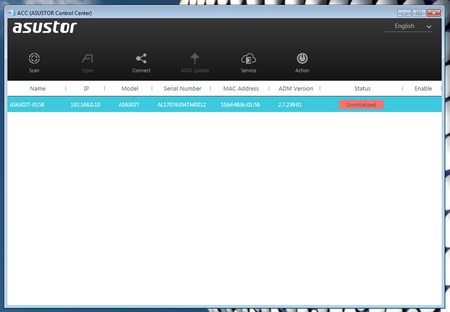














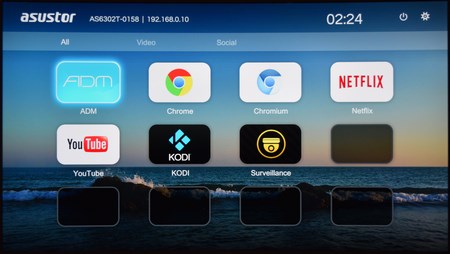






.png)

